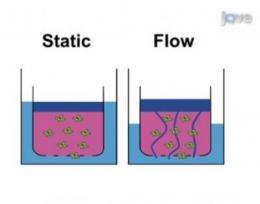How the fluid between cells affects tumors

There are many factors that affect tumor invasion, the process where a tumor grows beyond the tissue where it first developed. While factors like genetics, tissue type and environmental exposure affect tumor metastasis and invasion, physical forces like fluid flow remain a poorly understood component of tumor invasion.
A new video article in JoVE, the Journal of Visualized Experiments, describes a novel procedure that allows researchers to study and test the microenvironment of a growing tumor. The technique is valuable because it allows scientists to assay tumor invasion attributable to extracellular fluid flow in vitro and better understand the effects of such physical changes on a tumor. The study focuses specifically on a type of extracellular fluid called interstitial fluid, which flows between cells in a tissue. This procedure is a significant first step to develop an in vitro system that better mimics what happens within a growing tumor in the patient.
"Our goal is to understand how physical forces affect how tumor cells behave. By understanding factors influencing why a tumor does or does not spread, we will have a much better understanding of which therapies will affect the tumor," said the article's author Dr. Adrian Shieh of Drexel University.
As tumors grow, they promote angiogenesis, or growth of new blood vessels, within the tumor itself and the surrounding tissue. Due to the leaky nature of these new blood vessels, there is an increase in the interstitial fluid pressure and flow. Dr. Shieh notes that current research approaches and therapies are not designed for targeting, addressing or understanding these physiological changes. The procedure published in JoVE demonstrates a better way to measure and understand the effects of interstitial fluid flow on tumor cells.
To mimic this physiological process, cells are embedded in a collagen matrix and pressure is applied to the liquid environment. This pressure causes the liquid to flow around the cell, mimicking in vivo conditions of a developing tumor. This allows scientists to study tumor growth and evaluate potential new therapies on cells in culture systems that more closely resemble physiological conditions.
Dr. Shieh hopes that publication of this article in JoVE's video format will bring more awareness to the study of interstitial fluid flow in tumor cells and that it will demonstrate an accessible system to study the phenomenon. He emphasizes, "For many new techniques, even when accompanied by a detailed text protocol, it is very difficult for someone to pick up the procedure and correctly perform the assay. Tremendous expertise and hours of practice are needed to successfully complete this procedure. This multimedia publication format helps demonstrate the finesse required to perform this technique."
More information: Shieh et. al.: www.jove.com/video/4159/three- … or-measuring-effects
















